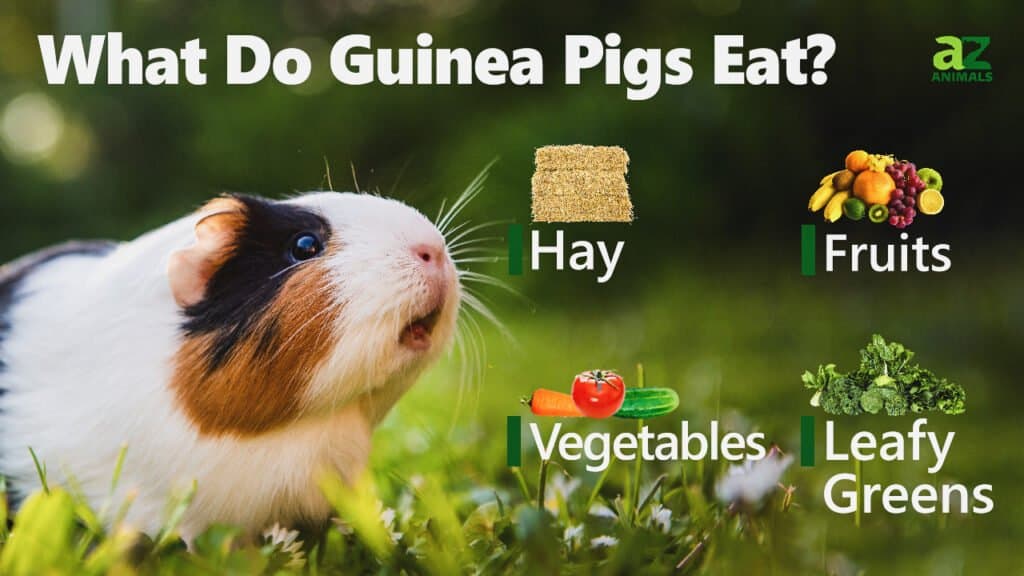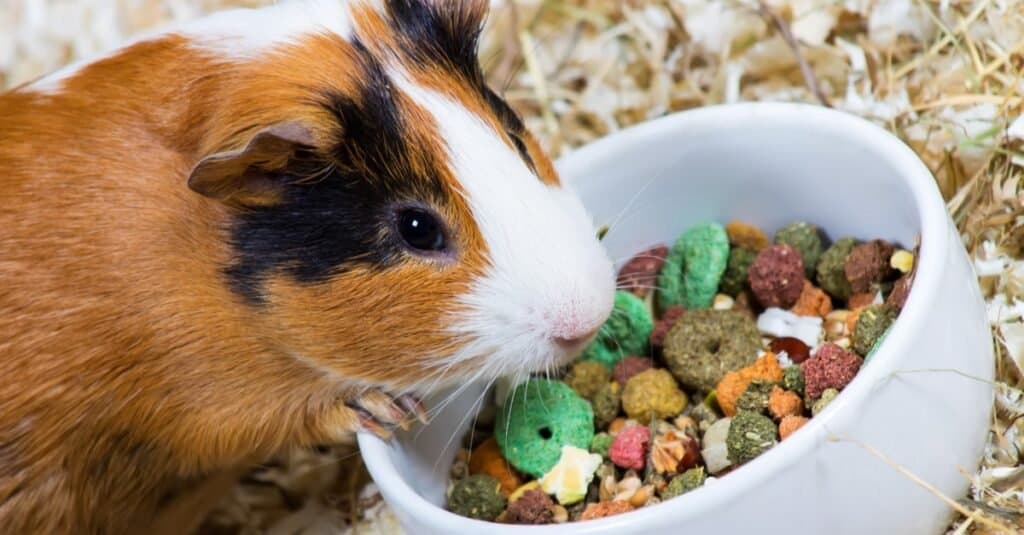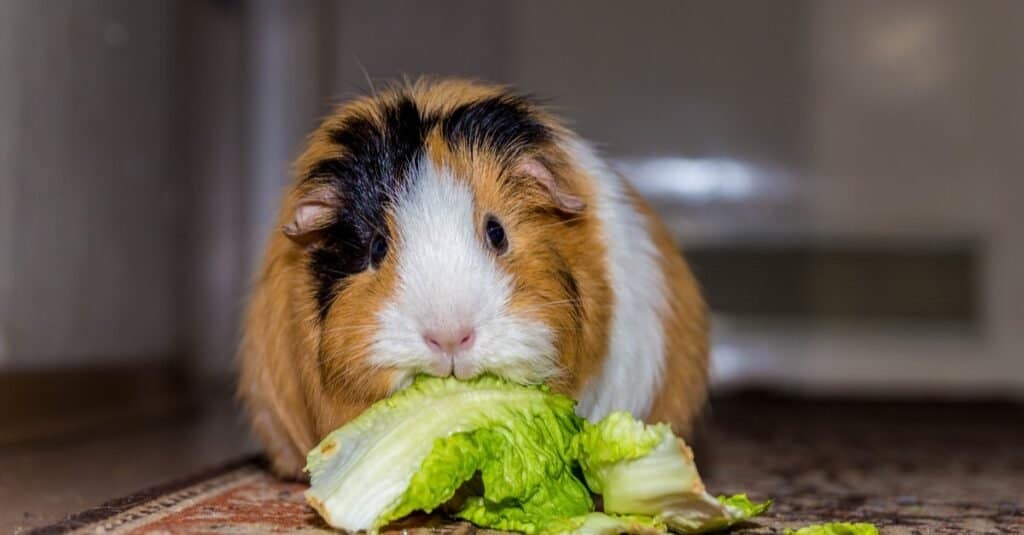
- They need plenty of hay to provide the nourishment they need and keep their teeth and digestive tract in excellent condition.
- They can also enjoy green vegetables and small quantities of fruit.
Guinea pigs are surprisingly fascinating pets: gentle, social, and full of complex behavior. But they’re also a lot of work to care for. The dietary routine is one of the most difficult aspects of their care because they can be a bit fussy and particular about what they eat. Guinea pigs are natural herbivores. While this species does not exist in the wild, owners should aim to replicate a “natural” diet as much as possible. This handy guide will provide all the information you need to know about what to feed it. A well-fed guinea pig is also a happy and healthy guinea pig. With a good diet and a bit of luck, these animals can live up to eight years old.
What to Feed Your Guinea Pig
A well-balanced guinea pig diet should feature a combination of commercial food, fresh hay, and fruits and vegetables. Commercial pellets will be an important part of its diet. Because guinea pigs, like humans, are unable to make their own vitamin C, they will do best with vitamin C fortified pellets with at least 16% fiber content and no additional seeds or dried fruits.
Pellets probably won’t be enough on their own, however. Because vitamin C can quickly degrade, it’s a good idea to combine this with leafy green vegetables and herbs. Romaine lettuce, red and green leaf lettuces, kale, and cilantro should form the bulk of its vegetable intake. Carrots, zucchini, dandelion greens, broccoli, cabbage, Brussels sprouts, sweet potatoes, and tomatoes can be added about once or twice a week as well. Freshly sliced fruits without any seeds, including oranges, apples, blueberries, mangos, pineapples, kiwis, and banana slices, should be given no more than once a day or every few days. Sugar intake, even in its natural form, needs to be limited.
Guinea pigs will also need a constant supply of hay (timothy, oaten, barley, or grassy hay should work well). This will help to improve their digestion and keep the teeth filed down as they chew on it. The hay should be kept in a rack or basket above the floor of the cage to prevent it from mixing with its waste.
Homemade treats like apple sauce mixed with hay are good options; this gives your pet something unique and interesting to chew on. However, in general, your guinea pig should be satisfied with a normal diet of pellets, hay, and fruits and vegetables. Commercial treats are usually unnecessary for a well-fed guinea pig. Many of them are full of artificial sweeteners and devoid of much nutritional content.
In addition to food, your pet will need fresh, clean water at all times of the day. Both a water bottle and a small water bowl should be incorporated into the cage. If the water bowl starts to get dirty, then you should replace it immediately, even though there could be some water remaining.

©Alexander Mozymov/Shutterstock.com
What NOT to Feed Your Guinea Pig
Because of its very particular herbivorous diet, guinea pigs, unfortunately, have a long list of foods to avoid. Even some vegetables that might seem okay at first glance could cause digestive issues for your pet. As a result, they should never eat nuts, seeds, dried beans, corns, peas, avocados, onions, mushrooms, dairy products, meat, and, of course, any human foods such as pasta, crackers, or sweets with little nutritional value. Some people feed them grains and cereals, but these are not ideal foods and should be avoided because they can some digestive problems.
Since most guinea pigs are vulnerable to developing bladder stones, you might want to eliminate or reduce foods with a significant amount of oxalates, including strawberries, spinach, and parsley.
Alfalfa hay should not be fed to your guinea pig on a regular basis as it can cause bladder stones and obesity.
However, its high calcium and protein content makes it an excellent choice of nourishment for pregnant pets and youngsters which are less than six months old.
Any plants from your garden sprayed from your pesticides should never be fed to your pet. You should always have a good idea of where the food comes from and whether it’s healthy enough to give your pet. You should find a trustworthy brand or food source and stick with it.
Some pet stores sell salt wheels and multi-vitamin supplements specifically tailored for guinea pigs, but this is actually a source of controversy. Some vets may approve their use, while others may tell you to avoid them. However, in general, as long as your pet is receiving enough nutrients in its diet, then these products are not necessary. In fact, some of the adhesives and chemicals used in these products could even conceivably be harmful to guinea pigs. Too many vitamins and minerals (especially salt) aren’t necessarily beneficial either. While it’s certainly possible to use supplements responsibly, they are best avoided just out of precaution unless part of a proper health treatment routine.
How Much to Feed Your Guinea Pig
The average guinea pig will need about 1/8 cup of pellets every single day. This should be supplemented with about a cup of vegetables and a few fruit slices per day. Unlimited quantities of hay should be left out in the cage and replaced immediately once it starts to get empty. As long as you stick to this routine and don’t overindulge your pet with tasty treats, you shouldn’t worry about the guinea pig overeating too much. They are usually quite good at understanding exactly how much food they need every day.
However, if it appears that your pig is putting on a bit of weight, then you might want to cut down on the extra treats just a bit. Treats, including fruit, should never exceed 10% of the daily food intake. A healthy guinea pig will weigh between 1.5 and 2.6 pounds.
It’s very important to keep in mind, however, that food and hygiene are closely connected. Owners should keep close track of how long food has been sitting out and then remove any uneaten bits after several hours to prevent your guinea pig from getting sick. If your guinea pig is consistently leaving out uneaten food, and it appears otherwise healthy, then it might be a sign that you should cut back on the amount of food you give it. Another problem is that guinea pigs will also sometimes accidentally kick bedding material or waste into their food bowl. This should be cleaned out almost daily as well.
When to Feed Your Guinea Pig
The timing of its meal doesn’t matter too much, as long as it’s on a consistent schedule. Morning and evening are usually good times in the day to offer treats and refill food bowls. As mentioned previously, an unlimited supply of hay should be provided constantly at all times throughout the day.

©Tomasz Stepien/Shutterstock.com
Signs of a Dietary Deficiency
Just like humans, a poorly fed guinea pig is also prone to dietary deficiencies. For reasons mentioned previously, vitamin C is the most common deficiency in guinea pigs. A consistent deficit in vitamin C will put your pet at risk of scurvy. Signs and symptoms include weight loss, crusty eyes, lack of energy, rough coat or hair loss, a ginger walk or limp, and diarrhea. At least 10 milligrams of vitamin C per day for a healthy adult (and at least 30 milligrams for a pregnant female) should be enough to prevent this from occurring. It’s okay to go a bit above this, but you should never exceed 50 milligrams per day unless directed by your vet.
Some animals may develop a vitamin C deficiency even when they have enough of it in their diet. This may be a sign of another health problem. Talk with your vet to ensure a full health evaluation is done. With the supervision of your vet, the solution is usually to give your pet enough vitamin C doses either orally or by injection at least once or twice a week.
Other Considerations
Besides these basic recommendations, there are a few other important tips that owners should keep in mind.
First, owners should buy a ceramic food bowl, preferably with a wide and shallow surface, rather than a plastic one. Ceramic is much more resistant to chewing and is difficult to turn over. It should be placed in a corner where they are unlikely to defecate. The bowl can be easily cleaned with soapy water and then thoroughly dried on a regular basis throughout the week.
The second thing to keep in mind: if you need to change your pet’s diet for any reason, then make sure you do it gradually over the course of a few weeks. Guinea pigs generally develop specific food habits early in their lives and do not take changes very easily. The introduction into the diet of new fruits and vegetables may cause diarrhea as well. If this occurs, then you should reduce the amount of produce for a few days and reintroduce it in smaller quantities.
Third, homegrown foods picked from your garden or near your home are generally okay provided they meet the criteria for accepted foods and haven’t been sprayed with any kind of pesticide or chemical treatment.
Finally, you should keep in mind that it is natural for guinea pigs to consume their own feces. This is not a sign of a deficiency of any kind. It is simply part of their natural behavior.
Up Next…
Keep reading these posts for more incredible information about key animal facts.
- Guinea Pigs as a Pet: How to Care for Your Guinea Pig: They’re smart and affectionate and thrive under the very best care. Here’s how to make sure they get it.
- How Much Does a Guinea Pig Cost Per Year? Just how far will you have to dig into your coffers to keep your tiny furry friend, well watered, well fed and in excellent health? Find out here.
- Guinea Pig Lifespan: How Long Do Guinea Pigs Live? Are these pets exceptionally long lived? We reveal the answer here as well as tips for keeping them in optimal health.
The photo featured at the top of this post is © iStock.com/Ольга Гурьянова
Thank you for reading! Have some feedback for us? Contact the AZ Animals editorial team.






